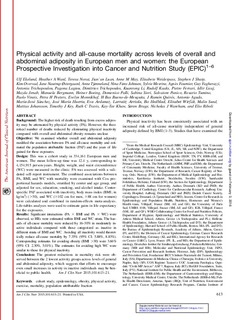| dc.contributor.author | Ekelund, Ulf | |
| dc.contributor.author | Ward, Heather A. | |
| dc.contributor.author | Norat, Teresa | |
| dc.contributor.author | Luan, Jian'an | |
| dc.contributor.author | May, Anne M. | |
| dc.contributor.author | Weiderpass, Elisabete | |
| dc.contributor.author | Sharp, Stephen J. | |
| dc.contributor.author | Overvad, Kim | |
| dc.contributor.author | Østergaard, Jane Nautrup | |
| dc.contributor.author | Tjønneland, Anne | |
| dc.contributor.author | Johnsen, Nina Føns | |
| dc.contributor.author | Mesrine, Sylvie | |
| dc.contributor.author | Fournier, Agnès | |
| dc.contributor.author | Fagherazzi, Guy | |
| dc.contributor.author | Trichopoulou, Antonia | |
| dc.contributor.author | Lagiou, Pagona | |
| dc.contributor.author | Trichopoulos, Dimitrios | |
| dc.contributor.author | Li, Kuanrong | |
| dc.contributor.author | Kaaks, Rudolf | |
| dc.contributor.author | Ferrari, Pietro | |
| dc.contributor.author | Licaj, Idlir | |
| dc.contributor.author | Jenab, Mazda | |
| dc.contributor.author | Bergmann, Manuela | |
| dc.contributor.author | Boeing, Heiner | |
| dc.contributor.author | Palli, Domenico | |
| dc.contributor.author | Sieri, Sabina | |
| dc.contributor.author | Panico, Salvatore | |
| dc.contributor.author | Tumino, Rosario | |
| dc.contributor.author | Vineis, Paolo | |
| dc.contributor.author | Peeters, Petra H. | |
| dc.contributor.author | Monnikhof, Evelyn | |
| dc.contributor.author | Bueno-de-Mesquita, H. Bas | |
| dc.contributor.author | Quirós, José Ramón | |
| dc.contributor.author | Agudo, Antonio | |
| dc.contributor.author | Sánchez, María-José | |
| dc.contributor.author | Huerta, José-Maria | |
| dc.contributor.author | Ardanaz, Eva | |
| dc.contributor.author | Arriola, Larraitz | |
| dc.contributor.author | Hedblad, Bo | |
| dc.contributor.author | Wirfält, Elisabet | |
| dc.contributor.author | Sund, Malin | |
| dc.contributor.author | Johansson, Mattias | |
| dc.contributor.author | Key, Timothy J. | |
| dc.contributor.author | Travis, Ruth C. | |
| dc.contributor.author | Khaw, Kay-Tee | |
| dc.contributor.author | Brage, Søren | |
| dc.contributor.author | Wareham, Nicholas J. | |
| dc.contributor.author | Riboli, Elio | |
| dc.date.accessioned | 2016-04-06T07:52:36Z | |
| dc.date.available | 2016-04-06T07:52:36Z | |
| dc.date.issued | 2015-01-14 | |
| dc.identifier.citation | American Journal of Clinical Nutrition. 2015, 101, 613-621. | nb_NO |
| dc.identifier.uri | http://hdl.handle.net/11250/2384128 | |
| dc.description | This is an open access article distributed under the CC-BY license (http://creativecommons.org/licenses/by/3.0/). | nb_NO |
| dc.description.abstract | Background: The higher risk of death resulting from excess adiposity may be attenuated by physical activity (PA). However, the theoretical number of deaths reduced by eliminating physical inactivity compared with overall and abdominal obesity remains unclear.
Objective: We examined whether overall and abdominal adiposity modified the association between PA and all-cause mortality and estimated the population attributable fraction (PAF) and the years of life gained for these exposures.
Design: This was a cohort study in 334,161 European men and women. The mean follow-up time was 12.4 y, corresponding to 4,154,915 person-years. Height, weight, and waist circumference (WC) were measured in the clinic. PA was assessed with a validated self-report instrument. The combined associations between PA, BMI, and WC with mortality were examined with Cox proportional hazards models, stratified by center and age group, and adjusted for sex, education, smoking, and alcohol intake. Center-specific PAF associated with inactivity, body mass index (BMI; in kg/m2) (>30), and WC (≥102 cm for men, ≥88 cm for women) were calculated and combined in random-effects meta-analysis. Life-tables analyses were used to estimate gains in life expectancy for the exposures.
Results: Significant interactions (PA × BMI and PA × WC) were observed, so HRs were estimated within BMI and WC strata. The hazards of all-cause mortality were reduced by 16–30% in moderately inactive individuals compared with those categorized as inactive in different strata of BMI and WC. Avoiding all inactivity would theoretically reduce all-cause mortality by 7.35% (95% CI: 5.88%, 8.83%). Corresponding estimates for avoiding obesity (BMI >30) were 3.66% (95% CI: 2.30%, 5.01%). The estimates for avoiding high WC were similar to those for physical inactivity.
Conclusion: The greatest reductions in mortality risk were observed between the 2 lowest activity groups across levels of general and abdominal adiposity, which suggests that efforts to encourage even small increases in activity in inactive individuals may be beneficial to public health. | nb_NO |
| dc.language.iso | eng | nb_NO |
| dc.publisher | HighWire Press | nb_NO |
| dc.subject | cohort study | nb_NO |
| dc.subject | epidemiology | nb_NO |
| dc.subject | obesity | nb_NO |
| dc.subject | physical activity | nb_NO |
| dc.subject | exercise | nb_NO |
| dc.subject | mortality | nb_NO |
| dc.subject | population attributable fraction | nb_NO |
| dc.title | Physical activity and all-cause mortality across levels of overall and abdominal adiposity in European men and women: the European prospective investigation into cancer and nutrition study (EPIC) | nb_NO |
| dc.type | Journal article | nb_NO |
| dc.type | Peer reviewed | nb_NO |
| dc.subject.nsi | VDP::Medical disciplines: 700 | nb_NO |
| dc.subject.nsi | VDP::Medical disciplines: 700::Clinical medical disciplines: 750 | nb_NO |
| dc.subject.nsi | VDP::Medical disciplines: 700::Health sciences: 800 | nb_NO |
| dc.source.journal | American Journal of Clinical Nutrition | nb_NO |
| dc.identifier.doi | 10.3945/ajcn.114.100065 | |
| dc.description.localcode | Seksjon for idrettsmedisinske fag / Department of Sports Medicine | nb_NO |
